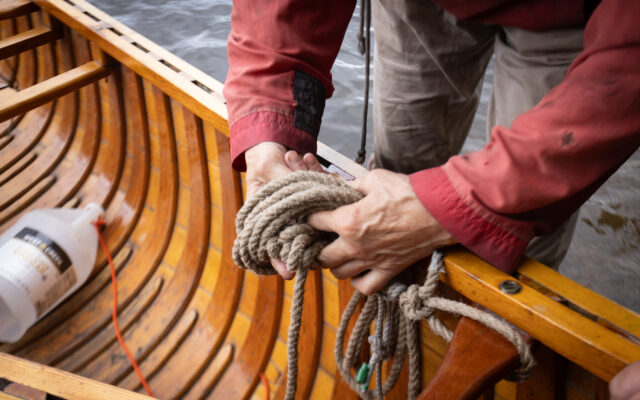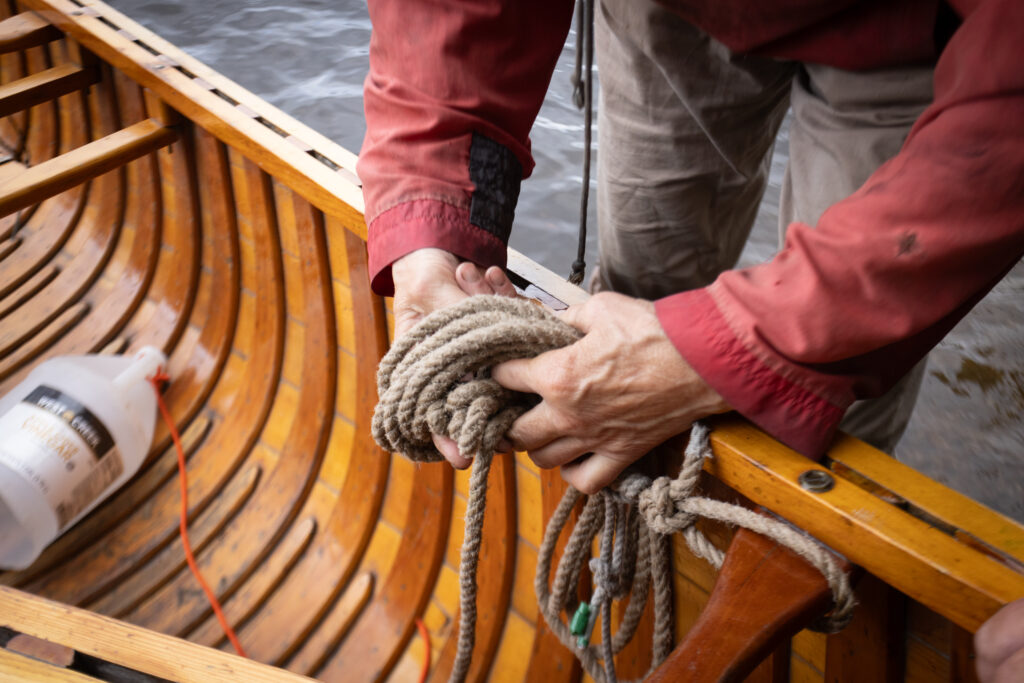
Traditional canoe camping skills and gear I didn’t know I lacked
By Aislinn Sarnacki
Years ago, I purchased a used canoe for a few hundred dollars. It’s big, red and seems to list to the side a bit. But it does the trick.
I’ve paddled it around lakes and down streams. I tossed a tent into it once and camped on the edge of a remote pond, deep in Maine’s 100-Mile Wilderness. The trip involved minimal planning and campfire hot dogs for dinner.
Suffice it to say, I’ve a lot to learn about traveling by canoe, a watercraft that has such a rich history in Maine.
For countless generations, the area’s native people paddled birch bark canoes as they moved between hunting grounds, fishing camps and villages. The waterways served as their roads.Â

CANOE CAMPING — Registered Master Maine Guide Polly Mahoney collects rope into a tied bundle to keep things orderly in a canoe. When canoe camping ropes can be used to tie down gear and secure the boat to other objects, like a tree on the shore.
Today’s indigenous people still celebrate and care for these routes.
In more recent history, canvas canoes have served as a primary vehicle for traditional guided trips through the Maine wilderness — whether for hunting, fishing or exploration. Within these spacious boats, guides can carry everything but the kitchen sink. Actually, scratch that. They usually carry a sink for washing dishes.
Nowadays, canoes are usually constructed out of materials like fiberglass, Kevlar and heavier plastics. Yet some people stick to the old ways. Mahoosuc Guide Service out of western Maine leads multi-day canoe trips in wood and canvas canoes that co-founder Kevin Slater designed.
I recently attended one of their trips — a women-only canoe expedition in the Grand Lake Stream area. The amount I learned in just five days blew me away.
Our 12-person group traveled in pairs, two per canoe. The only person I’d met briefly before was Polly Mahoney, co-founder of Mahoosuc Guide Service. So my first challenge was to force my introverted self to quickly make friends.
I was paired up with Ellen Maling, a fascinating world traveler who used to guide canoe trips in Alaska. Right away, she taught me the value of sinking into a rhythm as paddling buddies. Each day, we traveled between 4 and 12 miles, which meant hours on the water. It was important to pace ourselves.
Much of what I learned was about effectively and safely packing for a canoe camping trip. In the past, I’ve tossed items into the boat and hoped for the best.
But Mahoosuc Guide Service has a particular way of doing things that starts with arranging gear so that the canoe sits evenly in the water when the paddlers are both sitting, with just a little more weight in the stern (back).
For gear, we each packed our personal items — clothing, tent, sleeping pad, sleeping bag etc. — in a large dry bag. I borrowed a dry bag from the guide service because I own only small ones. Now that I’ve discovered how handy it is, I’ve placed it on my list of outdoor gear to buy.
In addition, we each filled a small dry bag with items that we might want to access while paddling, such as sunscreen, snacks and rain gear. We buckled this to our canoe seat for easy access. Many of the paddlers also used cords and carabiners to secure a water bottle to their seat.
The rest of the trip supplies, including coolers of food, cast iron cookware, tarps, a toilet seat and camp chairs, were divided among the boats. Then, everything was tied in with ropes and a variety of knots that were easy to untie yet would keep everything in the boat if it capsized.
Our second guide, Jennifer Neptune of the Penobscot Nation, helped me learn the knots. She later taught me how to set up a reflector oven at the edge of a campfire.
Throughout the trip, I picked up several tips for conducting camp chores.
Every night, I teamed up with someone to divide firewood into 1-foot sections with a bow saw. From Polly, we learned to not push down on the saw or it would catch on the wood. “Let the saw do the work,†she told us.
I also learned it’s more efficient to pull my elbow back to my side when sawing.
I was reminded that cedar wood is some of the best for starting a fire. It also smells glorious. We found loads of it sunbleached and smoothed by the waves along the shore, so we sawed it up for our evening cookfire. Polly split it with an ax.
We dealt with a bit of rain on our trip, but it didn’t dampen our collective mood. The only guarantee about Maine weather is that it’s ever-changing.
I learned that an extra tarp is always useful for rainy days. And of all the high-tech clothing I packed, it was my thrifted $10 wool shirt that kept me warm and dry.
My fancy rain jacket leaked in a dozen places, and my baseball cap sucked up water like a sponge. So when I returned, I purchased a new rain jacket and a light-weight, quick-drying hat.
I’m prepared for my next canoe trip, which is this weekend. I’m headed to a lake in western Maine this time, with hopes of learning more from Polly and all the other women in attendance.
The best way to acquire outdoor skills, I’ve found, is directly from another person. That way, you can practice, hands-on, and benefit from instant critique. So, if you find someone who’s generous enough to share their knowledge, pay attention.
With each outing, you can become more capable and confident in the Maine outdoors.